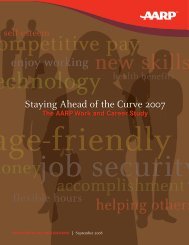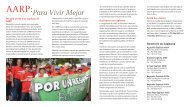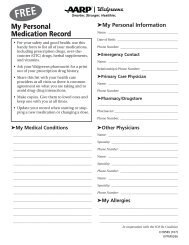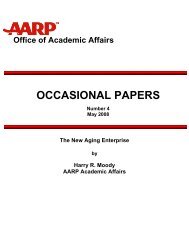Exercise Attitudes and Behaviors: A Survey of Adults Age 50-79 - Aarp
Exercise Attitudes and Behaviors: A Survey of Adults Age 50-79 - Aarp
Exercise Attitudes and Behaviors: A Survey of Adults Age 50-79 - Aarp
You also want an ePaper? Increase the reach of your titles
YUMPU automatically turns print PDFs into web optimized ePapers that Google loves.
Key Findings<br />
<strong>Exercise</strong> takes many forms<br />
• Walking (88%) <strong>and</strong> moderate physical activity (83%) are the most<br />
popular forms <strong>of</strong> exercise during a typical week among adults <strong>50</strong>-<strong>79</strong>.<br />
• Sizeable numbers also participate in vigorous activities (41%) <strong>and</strong> do<br />
things to increase muscle tone or strength (32%).<br />
• Moderate <strong>and</strong> vigorous activities vary widely—as substantial<br />
percentages walk, do yard work, clean house, or play sports to get in<br />
their exercise.<br />
Most are aware that community-based exercise programs <strong>and</strong> services<br />
exist for people their age<br />
• Two in three (67%) say there are at least “some” programs in their<br />
community.<br />
• One in six (15%) are currently participating in such programs; nearly<br />
half (42%) have at some time in their lives.<br />
• Weight lifting/strength training (31%) <strong>and</strong> aerobics (22%) are the most<br />
popular community-based exercise programs.<br />
• Reasons people have stopped taking or have never taken advantage <strong>of</strong><br />
community programs range from health reasons to preferring to<br />
exercise in private to finding the facilities too inconveniently located.<br />
Americans <strong>50</strong>-<strong>79</strong> have different views when it comes to staying fit <strong>and</strong><br />
living a healthy lifestyle. The results <strong>of</strong> a multivariate segmentation<br />
analysis reveals that they tend to fall into one <strong>of</strong> six groups:<br />
Socializers: Tend to be male, younger than average, <strong>and</strong> exercise<br />
regularly to have fun, be with friends—<strong>and</strong> improve their sex lives. Threequarters<br />
are “very satisfied” with life—the highest proportion among all<br />
segments.<br />
Maintainers: Includes both men <strong>and</strong> women, many in their <strong>50</strong>’s, who<br />
take a practical <strong>and</strong> relatively narrow approach—exercising to stay healthy<br />
<strong>and</strong> fit. They are especially likely to be in “very good” health (47%).<br />
Mind & Body: Women <strong>of</strong> all ages fit into this group, a segment that takes<br />
an overall approach to exercise—they exercise not only to stay in shape,<br />
but for emotional <strong>and</strong> psychological reasons as well. They are the most<br />
likely to be in “very good” health (55%).<br />
© 2002 AARP Page 10










